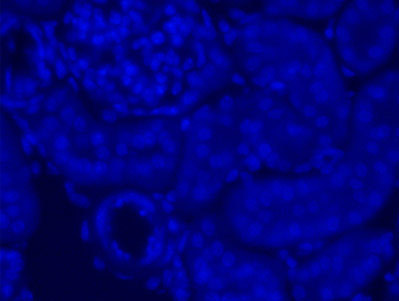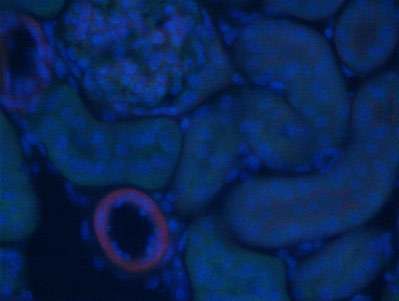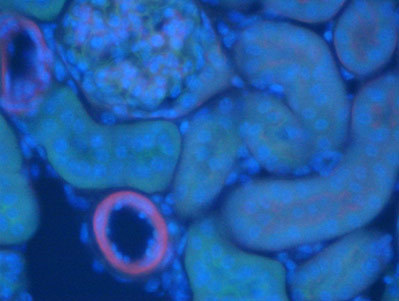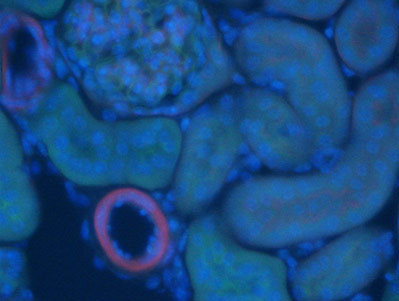Ultraviolet Excitation Filter Sets
Included in the Nikon ultraviolet excitation fluorescence filter portfolio are four carefully balanced combinations that contain either bandpass or longpass emission (barrier) filters capable of selectively isolating fluorescence emission through either a narrow or wide region of the blue, green, and red visible wavelengths. These filter combinations cover an excitation wavelength range between 330 and 380 nanometers with passband width profiles of 10, 40, and 50 nanometers. Three of the combinations employ the same dichromatic mirror, while the fourth set has a mirror with a lower wavelength cut-on to coincide with its narrower excitation band. The ultraviolet filter sets contain either longpass or single bandpass emission filters.
Figure 1 - Ultraviolet Fluorescence Excitation Filter Set Performance
Performance of the ultraviolet filter sets can be judged by comparing images from the same viewfield captured with each of the individual filter combinations, as illustrated in Figure 1. The specimen is a thin cryostat tissue section (16 micrometers) obtained from mouse kidney and stained with a combination of three fluorophores. Elements of the glomeruli and convoluted tubules in the thin section were labeled with Alexa Fluor 488 (green emission) wheat germ agglutinin. The filamentous actin inhabiting the glomeruli and the brush border were stained with Alexa Fluor 568 (red emission) phalloidin, while DNA in the nuclei was counterstained with DAPI (blue emission) to round out the labeling regime.
The lone bandpass emission filter in the Nikon ultraviolet excitation series, the UV-2E/C, produces images with a deep blue color on a jet black background (Figure 1(a)), and is ideal for use in multi-color fluorescence imaging with other excitation filter combinations. The bandpass emission filter in the UV-2E/C combination eliminates fluorescence from red and green fluorophores in specimens labeled with multiple probes. The UV-1A filter combination (Figure 1(b)) contains a very narrow excitation band (10 nanometers) that coincides with the wavelength of the mercury i-line (365 nanometers) produced by common arc-discharge lamps. This filter combination is designed to minimize autofluorescence through a narrow bandpass excitation region, while simultaneously passing all emission wavelengths exceeding 420 nanometers. The dichromatic mirror in the UV-1A filter set has the shortest cut-on wavelength (380 nanometers) in the ultraviolet series.
Interactive Tutorial - Ultraviolet Excitation
Examine specimen contrast with longpass and shortpass filter sets.
Often referred to as the standard ultraviolet set, the UV-2A combination is equipped with a 50-nanometer bandpass excitation filter that covers most of the longer wavelength ultraviolet region. Coupled to a 400-nanometer cut-off dichromatic mirror and a longpass emission filter, the UV-2A produces the brightest images of any filter combination in the Nikon ultraviolet set (Figure 1(c)). The UV-2B is similar in profile to the UV-2A, but is equipped with a longer cut-on wavelength (red-shifted by 15 nanometers) barrier filter in order to reduce background fluorescence. When compared to the UV-2A (Figures 1(c) and 1(d)), the UV-2B produces a much darker background with superior overall image contrast. Specifications for the dichromatic mirrors and filters from the various Nikon ultraviolet filter combinations are listed in Table 1.
Table 1 - Nikon Ultraviolet Filter Combination Specifications
| Filter Set Description | Excitation Filter (nm) | Dichromatic Mirror (nm) | Barrier Filter (nm) | Remarks |
|---|---|---|---|---|
| UV-1A | 365/10 (360-370) | 380 (LP) | 420 (LP) | Narrow Excitation Band Longpass Barrier Filter |
| UV-2A | 355/50 (330-380) | 400 (LP) | 420 (LP) | Standard UV Cube Longpass Barrier Filter |
| UV-2B | 355/50 (330-380) | 400 (LP) | 435 (LP) | Darker Background Longpass Barrier Filter |
| UV-2E/C | 360/40 (340-380) | 400 (LP) | 460/50 (435-485) | Medium Excitation Band Bandpass Barrier Filter |
- UV-2E/C - The UV-2E/C filter combination is designed as a sharp cutoff filter block for ultraviolet fluorescence. Filters are the soft-coated type intended to generate a high signal/noise ratio. The narrow bandpass barrier filter utilized in this combination is designed to dramatically reduce or completely eliminate green and red visible wavelengths.
- UV-1A - The UV-1A combination is designed as a filter block for ultraviolet fluorescence with a narrow excitation bandpass (only the i-line of the mercury spectrum is utilized) and a narrow dichromatic mirror passband, which minimizes autofluorescence and photobleaching.
- UV-2A - The UV-2A filter combination is designed as a standard filter block for ultraviolet fluorescence and is the brightest ultraviolet filter set in the Nikon palette.
- UV-2B - The UV-2B combination is designed as a general purpose filter block for ultraviolet fluorescence that provides a darker background and better contrast than the UV-2A filter combination.
A wide array of fluorophores has been developed for investigations using excitation wavelength spanning the ultraviolet region. Catalogued in Table 2 are some of the most popular dyes and fluorescent probes that can be visualized with the Nikon ultraviolet filter combinations. The localized environment significantly influences fluorophore absorption and emission spectra maximum (peak) wavelengths, so the values presented in Table 2 may vary with experimental conditions. This list is intended to serve only as a guide for filter and fluorophore selection and should not be considered a comprehensive or exhaustive compilation. Many of the fluorescent probes included in Table 2 are proprietary and have been developed to minimize photobleaching while ensuring a maximum overlap between the fluorochrome absorption and emission spectra and common fluorescence filter combinations. Note that due to broad absorption and emission bands, several of the fluorescent probes listed in Table 2 are also suitable for use with filter combinations having violet and blue-violet excitation passband regions.
Table 2 - Fluorochromes with Ultraviolet Excitation Spectral Profiles
| Fluorochrome | Excitation Wavelength (Nanometers) | Emission Wavelength (Nanometers) | Recommended Filter Set(s) |
|---|---|---|---|
| Acridine Blue | 362 | 462 | UV-2A, UV-2B UV-2E/C |
| AFA (Acriflavin Feulgen SITSA) | 355-425 | 460 | UV-2A, UV-2B UV-2E/C |
| Alexa Fluor 350 | 346 | 442 | UV-2A, UV-2B UV-2E/C |
| Alexa Fluor 405 | 401 | 421 | UV-2A, UV-2B UV-2E/C |
| AMCA (Aminomethylcoumarin Acetic Acid) | 345 | 445 | UV-2A, UV-2B UV-2E/C |
| AMCA-X (AMCA Succinimidyl Ester) | 353 | 442 | All |
| Aminoquinoline | 355 | 550 | UV-1A, UV-2A UV-2B |
| Aniline Blue | 370 | 509 | UV-1A, UV-2A UV-2B |
| ANS (Anilinonaphthalene Sulfonic Acid) | 372 | 455 | All |
| Anthroyl Stearate | 371 | 446 | All |
| BAO 9 (Bisaminophenyloxadiazole) | 365 | 395 | UV-1A, UV-2A |
| BFP (Blue Fluorescent Protein) | 380 | 440 | All |
| Bisbenzamide | 360 | 605 | UV-2A, UV-2B UV-2E/C |
| Blancophor SV | 370 | 435 | All |
| Blue FluoSpheres | 350 | 440 | All |
| Blue FluoSpheres (Short Wavelength) | 365 | 415 | UV-1A, UV-2A |
| Calcein Blue | 370-375 | 420-435 | All |
| Calcofluor RW | 370 | 440 | All |
| Calcofluor White (Standard Solution) | 365 | 435 | All |
| Cascade Blue | 370 | 425 | UV-1A, UV-2A |
| Cascade Yellow | 402 | 545 | UV-1A, UV-2A |
| CCF2 (GeneBLAzer) | 402 | 520 | UV-1A, UV-2A |
| CellTracker Blue Dyes (Aminochloromethylcoumarins) | 354-372 | 466-470 | All |
| CPM Probes (Maleimide Coumarins) | 375-385 | 460-475 | All |
| DANS (Dimethylaminonaphthalene) | 340 | 525 | UV-2A, UV-2B |
| DANSA (Diamidinonaphthyl Sulfonic Acid) | 360 | 430 | UV-1A, UV-2A |
| Dansyl Probes | 335-380 | 475-575 | All |
| DAPI (Diamidinophenylindole) | 358 | 461 | All |
| Dapoxyl Probes | 375-400 | 575-600 | UV-1A, UV-2A UV-2B |
| DIDS (Diisothiocyanatostilbene Disulfonic Acid) | 341 | 415 | UV-1A, UV-2A |
| Dimethylamino Sulfonic Acid | 340 | 520 | UV-2A, UV-2B |
| DIPI (Bisimidazolinylphenylindole) | 364 | 455 | UV-2A, UV-2B |
| Dopamine | 340 | 490-520 | UV-2A, UV-2B |
| DPH (Diphenylhexatriene) | 350 | 452 | UV-2A, UV-2B |
| ELF-97 Alcohol | 345 | 530 | UV-2A, UV-2B |
| EBFP (Enhanced Blue FP) | 380 | 440 | All |
| ERTracker Blue/White DPX | 374 | 575 | UV-2A, UV-2B |
| Fast Blue | 360 | 410 | UV-1A, UV-2A |
| Flazo Orange | 375-530 | 612 | UV-1A, UV-2A |
| Fluorescamine | 390 | 460-475 | UV-2A, UV-2B |
| FluoroGold (Hydroxystilbamidine) | 365 (High pH) 325 (Low pH) | 565 (High pH) 410 (Low pH) | All |
| Fura-2 | 335 (High Ca) 365 (Low Ca) | 505 (High Ca) 512 (Low Ca) | UV-2A, UV-2B |
| GFP (Blue Shifted, Y66H) | 382 | 448 | UV-2A, UV-2B |
| GFP (Wild Type) | 395 | 508 | UV-1A, UV-2A UV-2B |
| Gloxalic Acid | 405 | 460 | UV-2A, UV-2B |
| Granular Blue | 355 | 425 | UV-1A, UV-2A |
| Hoechst 33258 | 346 | 460 | All |
| Hoechst 33342 | 347 | 483 | All |
| Hoechst 34580 | 392 | 440 | All |
| HPTS (Hydroxypyrene Trisulfonic Acid) | 355 | 465 | All |
| Hydroxymethylcoumarin (Methylumbelliferone) | 360 | 455 | All |
| HAT (Hydroxytryptamine) | 370-415 | 520-540 | All |
| IAEDANS (Iodoacetylaminonaphthalene Sulfonic Acid) | 336 | 482 | UV-2A, UV-2B UV-2E/C |
| Indo-1 | 330 (High Ca) 346 (Low Ca) | 405 (High Ca) 475 (Low Ca) | All |
| Intrawhite CF | 360 | 430 | UV-1A, UV-2A |
| Laurdan | 364 | 497 | All |
| Leucophors | 370-395 | 430-465 | All |
| LysoSensor Blue | 373 | 425 | UV-1A, UV-2A |
| LysoSensor Yellow/Blue | 329 (High pH) 384 (Low pH) | 440 (High pH) 540 (Low pH) | UV-1A, UV-2A UV-2B |
| LysoTracker Blue | 373 | 422 | UV-1A, UV-2A |
| MAG Probes (Magnesium Indicators) | 330-350 | 420-505 | UV-2A, UV-2B |
| Marina Blue | 365 | 460 | All |
| Methoxycoumarins | 340-365 | 400-470 | All |
| Monochlorobimane | 380 | 461 | UV-2A, UV-2B |
| MPS (Methyl Green Pyronine Stilbene) | 364 | 395 | UV-1A, UV-2A |
| Noradrenaline | 340 | 505 | UV-2A, UV-2B |
| Nuclear Fast Red | 289-530 | 580 | UV-1A, UV-2A UV-2B |
| Nuclear Yellow | 365 | 495 | UV-1A, UV-2A UV-2B |
| OPT (o-Phthalaldehyde) | 340 | 455 | UV-2A, UV-2B |
| PBFI (Potassium Probe) | 334 (High K) 346 (Low K) | 525 (High K) 551 (Low K) | UV-2A, UV-2B |
| Phorwites | 360-380 | 430 | All |
| PMIA (Pyrenemethyl Iodoacetate) | 341 | 376 | UV-1A |
| Prodan | 361 | 498 | All |
| Pyrene | 345 | 378 | UV-1A |
| Pyrozal Brilliant Flavin 7GF | 365 | 495 | UV-1A, UV-2A UV-2B |
| QDots 525-655 | 350-450 | 525-655 | UV-2A, UV-2B |
| Quin-2 (Calcium Probe) | 332 (High Ca) 352 (Low Ca) | 492 (High Ca) 492 (Low Ca) | UV-2A, UV-2B |
| SBFI (Sodium Probe) | 334 (High Na) 346 (Low Na) | 525 (High Na) 551 (Low Na) | UV-2A, UV-2B |
| Serotonin | 365 | 530 | UV-2A, UV-2B |
| SITS (Stilbene Isothiosulphonic Acid) | 337 | 436 | UV-2A, UV-2B |
| SPQ (Methoxysulfopropylquinolinium) | 344 | 443 | UV-2A, UV-2B UV-2E/C |
| Stilbene | 335 | 440 | UV-2A, UV-2B UV-2E/C |
| Tetracycline | 390 | 560 | UV-2A, UV-2B |
| Thioflavin TCN | 350 | 460 | UV-2A, UV-2B UV-2E/C |
| Thiolyte | 380 | 480 | All |
| Tinopol CBS | 390 | 430 | UV-2A, UV-2B UV-2E/C |
| True Blue | 365 | 425 | UV-1A, UV-2A |
| Uvitex SFC | 365 | 435 | All |
Although the four filter combinations described above adequately serve in a majority of the investigations with ultraviolet wavelengths, several additional special filter sets are available from the aftermarket manufacturers. Fluorophores excited in the wavelength region between 250 and 300 nanometers benefit from filter combinations that include bandpass excitation filters centered in this area. These combinations also require dichromatic mirrors and barrier filters with cut-on wavelengths in the ultraviolet region (as well as detectors sensitive to ultraviolet). Filter sets designed for xenon arc-discharge lamp excitation contain wide bandpass excitation filters (approximately 100 nanometers) centered in the 300 to 400 nanometer region.
Other specialized filter sets contain emission filters with two bandpass regions for ratiometric analysis of ion-sensitive probes, such as Indo-1, FluoroGold, Fura-2, and the LysoSensor dyes. Other sets combine the narrow mercury i-line (365 nanometers) bandpass excitation filter with a bandpass emission filter (produced by merging elements of the UV-2E/C and UV-1A combinations) tailored specifically for dyes such as DAPI, Hoechst 33258, and AMCA. In addition, filter combinations for specific fluorophores have been developed. Among these are combinations designed for pyrene, ELF-97, Nuclear Fast Red, SPQ, Cascade Blue, and the gold probes. Filter sets having longpass filters with cut-on wavelengths in the yellow spectral region are useful for examining residual photoresist on semiconductor wafers.
Contributing Authors
Anna Scordato and Stanley Schwartz - Bioscience Department, Nikon Instruments, Inc., 1300 Walt Whitman Road, Melville, New York, 11747.
John D. Griffin, Nathan S. Claxton, Matthew J. Parry-Hill, Thomas J. Fellers



















